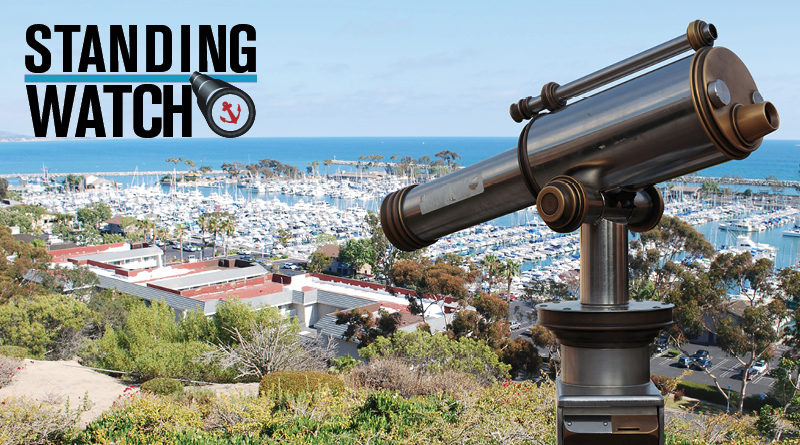The Cost of Future Waterfront Development: Our Past
Could plans to revitalize and modernize San Pedro help preserve history behind Fish Harbor?
SAN PEDRO — The presidential election of 2016 might have been one of the most polarizing political contests of recent memory. One of the most notable elements of the election was candidate Donald J. Trump’s campaign tagline: Make America Great Again. Pundits on the left and right certainly had a field day interpreting the meaning of “Make America Great Again” – but one thing was for certain, the campaign slogan was a call to return to someone’s version of a nostalgic past.
No one is rushing to the trademark office to patent a “Make San Pedro Great Again” slogan, but can the apparent rush to make the L.A. Harbor a viable and livable neighborhood actually help rekindle a piece of Los Angeles history we’ve almost fully forgotten?
The polarizing reactions to planned changes on the L.A. Waterfront in San Pedro might not rise to the level of what the nation experienced, politically, in 2016, but the concept of being uncomfortable with the breakneck speed of substantive and tangible changes coming to one of Los Angeles’s most distant neighborhoods would certainly not be lost on some.
Of course, there are many voices welcoming planned changes to the L.A. Waterfront, saying such revitalization and modernization is necessary. Both San Pedro and Wilmington are in a dilapidated state, these voices say, and changes are necessary in order to make both neighborhoods a more attractive place to visit or live.
Change, ultimately, is mercurial – sometimes it’s good, other times not so much. All we can hope for, over time, is the good changes outweigh the bad. The L.A. Waterfront featured one such bad change – the near complete erasure of Fish Harbor, a tuna cannery neighborhood primarily populated by immigrant and first-generation Japanese.
Commercial fishing boats would unload their sardine and tuna catches onto wharves staffed by Japanese crews, yet to limit the Fish Harbor narrative to a place of business would oversimplify the area’s history.
Several feature stories have been penned on the social and cultural nuances once found at Fish Harbor, which was located on the edge of Terminal Island closest to San Pedro. Authors Naomi Hirahara and Geraldine Knatz wrote an entire book on the history of Terminal Island’s neighborhoods, including Fish Harbor. The book – “Terminal Island: Lost Communities of Los Angeles Harbor” – noted Fish Harbor was built in 1915 as a means to organize the shipping and fishing industries into separate spaces within the port district.
Another attempt to reorganize the Port of Los Angeles is underway, a little more than 100 years after Fish Harbor was built – and, thus, a question is presented. What can the city of Los Angeles – which includes the Port of Los Angeles – do to honor the harbor’s past and pay some sort of homage to Fish Harbor?
An article recently published on Curbed L.A. stated the only signs of the former fishing neighborhood are two buildings and a broken sign with faded Japanese characters.
“In one of the buildings, there is a weathered restaurant. On a recent visit it was empty, save a lone person watching Donald Trump on Fox News. In a concrete yard next door, fishermen were rolling up a huge, tangled net. Tide goes in, tide goes out,” the article stated at its conclusion.
The neighborhood, as pointed out by the article prior to its somber finish, was once full of residents, living on the fringes of a man-made island from the early 1900s to the days leading up to the U.S.’s involvement in World War II.
“The canneries soon built more than 300 houses for workers and their families behind the harbor. A thriving community of around 2,000 to 3,000 souls was born,” the Curbed L.A. article stated. “The homes at Fish Harbor, called Furusato by the Japanese, were small, simple and utilitarian.”
Fish Harbor’s predominantly Japanese American population fostered a unique culture on Terminal Island, mixing languages together, playing baseball on a weekly basis and maintaining everyday elements of Japanese folklore.
Pearl Harbor changed the course of history at Fish Harbor. Federal agents, within months of the bombing and the U.S. entry into World War II, executed an order to relocated Japanese populations on the West Coast into internment camps. Attempts to revitalize Fish Harbor years later were never realized. Two buildings, a faded sign and a memorial now memorialize the former fishing neighborhood but the area certainly has a far greater historical significance.
An overview of L.A. Harbor’s history presented by the National Oceanic and Atmospheric Administration, for example, acknowledged the fishing and cultural contributions made by Japanese fishermen who lived and worked at Fish Harbor.
“Japanese [fishermen] used bamboo pole and line gear to catch skipjack tuna along the coast of Japan, and introduced these tools to U.S. tuna fishermen. This gear revolutionized the San Pedro based albacore fishing industry and was modified to catch large yellowfin tuna off the southern coast of the U.S.- Mexican border,” the NOAA historical perspective stated.
Should the city of Los Angeles and L.A. Waterfront developers make some sort of effort to include the past within its plans of modernization? Perhaps portions of the old fishing community could be preserved and provide visitors – all those tourists and locals the city and port district officials hope will flock to San Pedro once the revitalization is complete – a reason to patronize the area (as opposed to visiting the area to do some shopping or have a meal).
Could preserving at least a portion of Fish Harbor’s storied past as a cannery, neighborhood and World War II event also be a blueprint of how to maintain character and personality as waterfronts up and down the Southern California coast anxiously undergo revitalizations and makeovers?


